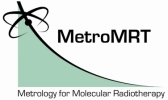WP4 - Modelling and uncertainty analysis
In the context of targeted therapies such as molecular radiotherapy, metrological traceability exists for activity delivered to the patient, but not for the absorbed dose in the target organ. The latter traceability together with an uncertainty budget is needed to assure adequate dosimetry performance levels that comply with regulatory requirements or patient care guidelines. In transferring traceability from delivered activity to absorbed dose, the manner in which absorbed dose depends on delivered activity needs to be understood. This process will be considered in terms of typical hospital protocols for standard treatments (eg 131I MIBG, 90Y DOTATATE, 177Lu DOTATATE) provided by UCL, and will be regarded as composed of a sequence of individual processes (such as obtaining quantitative activity data, generating activity-time curves, and calculating absorbed dose). Knowledge of the measurement uncertainties involved will constitute the basis of metrological traceability for absorbed dose.
Mathematical models of these processes will be constructed, enabling the absorbed dose for any specified delivered activity to be obtained. These models will describe how the absorbed dose depends on many influence factors (separate factors influencing the value of the measured quantity), including physical half-life of the radionuclide, fraction of the radionuclide that accumulates in the target organ, and biological half-life (which dictates the length of time the radionuclide remains in the organ). Propagation of uncertainties through the models will enable the formulation of an uncertainty budget and will yield a resultant uncertainty in the absorbed dose.
Uncertainties relating to influence factors will be deduced from instrument makers' specifications, published decay scheme tables, quantitative imaging, activity measurements, and other medical and biological data. WP1-3 will provide statistical data for the evaluation of the uncertainties related to activity measurement, quantitative imaging, and dose calculation, respectively. The knowledge gained will be used to assess the relative merits of imaging systems, whether or not to use patient-specific information, and optimisation of in vivo activity measurement time points.
In the recent EANM Dosimetry Committee guidance it is said, "One would expect that, in the near future, a rigorous calculation of the propagation of error (or propagation of uncertainty), including the fit process, will be performed and the errors reported." This workpackage intends to meet that expectation.
This workpackage has its basis in a set of mathematical models for radiotherapeutic measurands, and adheres closely to current internationally adopted guidelines for uncertainty evaluation (Guide to the expression of uncertainty in measurement - GUM - and GUM Supplement 1). It will be established whether conventional methods of propagating uncertainties (GUM) are suitable or, because of large contributing uncertainties and the complexity of the models involved, more rigorous methods based on propagating probability distributions are needed (GUM Supplement 1).
Task 4.1: Errors and uncertainties in input data and other quantities
The aim of this task is to identify major sources of error in the metrological processes involved in the measurement of absorbed dose, and to quantify them for the purpose of evaluating uncertainty budgets derived from the modelling and uncertainty analysis in Task 4.2. This aspect will be particularly demanding and is critically needed. Computational models such as Monte Carlo (MC) models will be used when appropriate, and will constitute an important component of this workpackage. For instance, MC is essential for camera quantification and absorbed deposition, particularly in non-homogeneous media. A key component of this task is the analysis of activity-time data (obtained with a gamma camera or by other means) to produce a faithful activity-time curve. A kinetic model of the target organ will be used that comprises a sum of terms, each term containing parameters representing the decay constant for the radionuclide used, an unknown patient-specific biological removal constant, and an unknown initial activity. The area under the activity-time curve and the associated uncertainty will be provided. This area is a main contributing factor to absorbed dose.
Task 4.2: Modelling and uncertainty evaluation
The aim of this task is to establish mathematical models of the processes involved in measuring absorbed dose in order to develop uncertainty budgets of the complete process. Uncertainties associated with the errors in these processes would be combined by propagation through the models to provide uncertainties associated with the given parameters used for dosimetry such as a quantitative image, and for the overall value of absorbed dose. For instance, account would be taken of the number of counts on which activity depends, since the consequential uncertainty reduces as this number increases. Other influence factors will be taken into consideration such as attenuation, background, dead time, and scatter. The relative contribution of the uncertainty associated with each of the links in the measurement chain to the uncertainty budget will be able to be estimated.
Task 4.3: Ramifications of modelling and uncertainty
The aim of this task is to use the overall absorbed dose model, the models that lead to it, in order to determine what the inherent uncertainties are, that are associated with the various methods of MRT dosimetry that are being developed by the unfunded JRP-Partners. The aim is also to use the results to predict the implications for the following:
- The relative importance of the steps in the metrology chain. Many steps in the chain have different possible approaches - as yet there are no standardised methods. There are in effect many 'parallel steps' that can be modelled and compared for their relative uncertainty contributions.
- An investigation into the benefits from reducing the uncertainty associated with the measurement of absorbed dose in individual MRT patients will be done. The implications for patient outcomes (tumour control probability, and normal tissue complication probability) and the improvement in statistical power of clinical trials will be investigated.
For more information: Contact Vere Smyth

